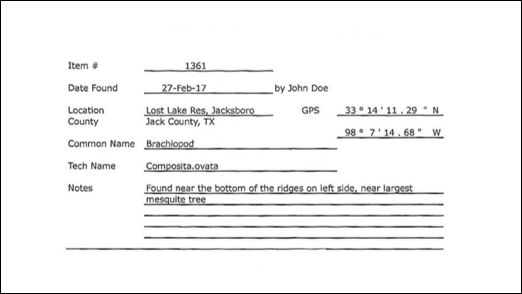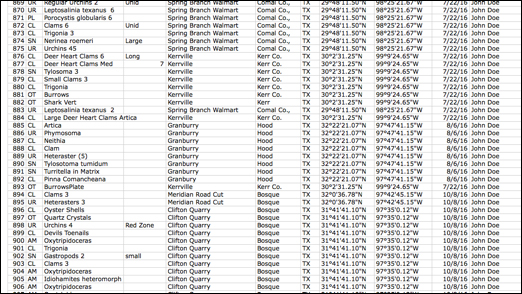by Jack Kallmeyer, Rocky Manning, and Rodney Wise
If you are like most fossil collectors, your family and friends know little about the value or importance of your collection. When the day comes that you are no longer of sound mind or you pass away, your heirs will need to know what to do with your collection. You need to leave a written plan for what to do with your fossils. You may want to include a donation of funds for preparing and housing the collection.
On the other hand, if you become the executor of an estate that includes a fossil collection you may be at a loss as to what to do with it.
This article will provide guidance on preparing a plan for your fossil collection and provide suggestions on what to do with an inherited fossil collection.
Create a Will and/or Fossil Estate Plan
First we will address the fossil collector’s need to provide a plan. For the first part of your plan, it is best to create a Will. In this Will, you will need to clearly specify directions for dissemination of your collection. If you do not want to put this level of detail in your will or do not have a will, create a Fossil Estate Plan document stating your wishes that will readily be found by heirs when needed. The Will can refer to this document. In the case where someone is no longer of sound mind, this document will provide guidance without having to resort to reading the Will. A Sample Fossil Estate Plan is provided at the end of this article. For those fossils that you know have scientific value, you should consider donating them to a museum or university while you are alive and able. This is the best way to transfer complete information about the fossils.
Document your collection
Your collection must be well documented in order for a museum or university to have interest in it. The reason is that fossils without locality information have little scientific value. The locality allows scientists to determine the geologic formation, age, paleoenvironment, and what other fossils are commonly found there.
Also, provide as much identification as you can. Get help from identification guides, searching the internet, the online Fossil Forum or the myFOSSIL website, contacting experts at the many amateur organizations around the country, or by contacting a professional paleontologist at a museum or university. Don’t get bogged down trying to identify all of your specimens though. Identification is nice to have but not absolutely necessary. Locality information, however, IS absolutely necessary.
There are many detailed commentaries on how to document a fossil collection. See myFOSSIL.org (http://www.myfossil.org/forums/topic/curation-of-personal-collections-2/) for a good starting point. The basics are:
Name of site
Location of site – GPS coordinates, address, map directions
Contact information (if needed to access the site)
Optional information: Formation, Genus/species, Dimensions, Description, and Photographs.
When applicable, a fossil’s provenance, or history of ownership, is also a key piece of information, especially for legacy collections handed down to you by your grandfather or other deceased relatives and friends. Provenance is also important if you have fossils you have purchased at fossil shows, gem and mineral shows, etc. A reputable museum or university will have an ethics policy that prohibits them from accepting donations of fossils from countries that have federal regulations regarding the exportation of fossils.
Select an institution
If you want your collection to go to an institution, it is best to build a relationship with a local university or museum ahead of time. That way you can determine what portion, if any, of your collection is of interest to the institution. This is critical. Museums and universities are not obligated to accept a collection just because the collection has been bequeathed to them in a will. If the institution does not have the resources in place to properly care for the collection, they have the right to turn down the donation.
Determine if the institution has a reference or research collection. Some museums, usually small ones, may have fossils on display but they are not committed to maintaining the collection and making the fossils available to researchers indefinitely. This means they can’t be used in research papers and their collection has little scientific value. If you have a scientifically significant collection and your local museum does not have a reference/research collection, you may want to look elsewhere. The best museums housing research collections will be accredited by the American Alliance of Museums.
If you want your collection displayed, you may want to try a small museum. Large museums with a reference collection usually won’t commit to displaying a collection unless it is very high quality material. Small museums may commit to display the material in order to get the donation for their exhibits, but these collections are not useful for research papers. Be advised, even small museums will not guarantee that donated items will remain on permanent exhibit.
If it is a specialized collection and no local researcher is very interested, you may ask around to find a researcher in another part of the world studying your material. They may be happy to get at least a portion of it.
You should identify the portion of your collection intended for the institution. That’s because, as stated earlier, the institution may not be interested in all of the collection. The remainder of the collection might be earmarked for donation to an earth science teacher or to an amateur paleontological organization.
Many amateur paleontological organizations are well equipped to handle estate collections. Discuss your collection with these organizations to be sure their methods meet your ultimate desires. Amateur organizations may already be aligned with universities and museums where they routinely donate fossils. These organizations can make the determination as where best to allocate your collection based upon the potential scientific value of the fossils in question. It is not uncommon for a collection to be distributed to a number of institutions. For parts of your collection that have no scientific value, e.g., no locality data, the amateur organization may be able to use those particular fossils in outreach programs or in their own fund raising projects
It is important to remember that once specimens are donated to another organization, and some version of a Deed of Gift form is signed, those specimens become the legal property of the organization and the donor and their family relinquishes all rights to them.

Determine value for tax purposes
You will be able to take an income tax charitable donation deduction, if the recipient institution such as an amateur organization, museum, or university is a qualified 501(c)3 nonprofit. The receiving institution will not provide a dollar value for tax deduction purposes. If the estimated dollar value is under $5,000.00, you do not need an official appraisal for tax purposes – but it is recommended to have some criteria established that led to the valuation. For this purpose, you could use estimates from commercial dealers or various internet sites like ebay.com. If the valuation is over $5,000.00, you will need a real appraisal from a recognized appraiser. The appraiser must meet certain IRS qualifications and cannot be just any dealer or club. You will probably need to pay for the appraisal.
As mentioned above, you may donate your collection to an amateur 501(c)3 organization to help further their work. If this organization sells or auctions off all or part of your collection, the actual proceeds received for your collection becomes your tax deductible contribution. This is what happens when you donate a car to Goodwill for example – you can only deduct what Goodwill gets for the car at auction, not what you think it is worth. The organization should be able to give you a statement for tax purposes. This statement will have a brief description of what was sold and the amount of money your collection brought to the group. The statement should contain wording that “you received no benefit” from your donation, as any benefit received would be deducted from the dollar value of the auction or sale. An example is the PBS fundraising programs wherein you get a DVD for your $100.00 donation; your tax deduction would be $80.00 because the DVD is valued at $20.00 (your benefit from the donation).
You want to sell it
Selling your collection is outside the purpose of this paper. If you must sell it, it is recommended that you at least show it to a professional paleontologist first to see if there is anything of particular scientific value. You might then donate that material.
You Are in Charge of Dissemination of a Fossil Estate
In the case where you are responsible for dissemination of someone’s fossil collection, here are some suggestions:
- If the collector left a plan, follow the plan as far as it goes.
- If family or friends are interested in any of the remaining material to continue the collection, give it to them as long as the plan allows for that.
- Contact an earth science teacher or amateur paleontology organization to help determine the scientific value of the rest.
- Anything of scientific value is best donated to a university or museum.
- If the collector did not leave a plan, contact a local museum, university, or amateur paleontological organization for help determining the scientific value. The amateur organization may be your best bet. They can contact professionals. See myFOSSIL.org (http://www.myfossil.org/paleosocieties/) for a list of amateur paleontological organizations.
- If you must sell it, first consider donating any scientifically significant items to a university or museum. There may be an opportunity to sell the fossils on ebay,through an estate sale, to an auction house or to a reputable dealer in fossils; however, this type of dissemination is beyond the scope of this paper.
Sample Fossil Estate Plan
Fossil Estate Plan for John Doe
In the event of my death or that I am not able to disseminate my fossil collection, these are the steps I would like to see carried out.
Fossils X, Y, and Z have scientific value and should be donated to ABC University. Professor A is the contact. $5,000 should be donated to ABC University for support of their fossil collections.
Fossil D should be given to Person A and Fossil E to Person B as they always admired these fossils.
If any family members or friends are interested in continuing my collection, they may take any of the remaining fossils providing they disseminate them in a manner similar to this plan, when they are no longer able to continue the collection.
The fossils in Container A should be offered to University A and Museum A as there may be something of value.
The rest of Container A and the remainder of the collection should be donated to the local amateur organization AAA Paleo Group for final dissemination. Some of the collection may be suitable as educational specimens for local schools. Other suggested uses are: display fossils for events, practice media in fossil preparation classes, fund raising items in auctions, and drawings and give away boxes.
The fossils will be found in display cases throughout the house and in boxes labeled “Fossils” in the second bedroom closet and the garage. Each box will include a list of the contents and each specimen will have the following identification label:
In addition, each specimen will be listed in an excel spreadsheet that has the number, name, and location listed. An example is below:
Thank you for following my direction. My hope is that my collection will further the knowledge and experience of others in the field of paleontology.
With my deepest thanks.
__________________________________________________________________
Signature of John Doe

